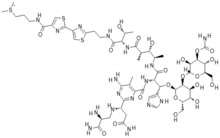Shabir Bhimji, MD(*) and Lionel Zumbro, MD. Cardiothoracic Surgery, Medical College of Georgia, Augusta, GA.
PURPOSE: The optimal duration and treatment of malignant pleural effusion (MPE) has not been resolved. In this study, we evaluated the efficacy of bleomycin as a sclerosing agent in patients with a MPE.
METHODS: Seventy nine consecutive patients with a known malignancy (37 breast, 17 ovarian, 6 lymphoma, 19 lung) and a symptomatic pleural effusion underwent tube thoracostomy and bleomycin pleurodesis. The average time of onset of effusion from diagnosis was 44 months. The median age of patients was 57 years. A thoracostomy tube was placed; in each patient and drainage continued until lung re-expansion occurred. Bleomycin (60 units) was instilled into the pleural cavity only after the pleural effusion was completely drained. Repeat bleomycin was undertaken if the patient did not have a temperature spike.
RESULTS: The mean volume drained after chest tube placement was 2.7 liters over 2 days. All patients became asymptomatic after drainge of the MPE. All except 2 patients developed a fever after instillation of bleomycin. Over a one month period, a complete response (no recurrence) was obtained in 68 patients and a partial response (re-accumulation of pleural fluid) in 9 patients. Seventy one patients were discharged home within 3 days. Three recurrences required repeat thoracostomy tube and bleomyein pleurodesis. One patient required video assisted pleurodesis and one patient required a partial pleurectomy. There were two in hospital deaths because of extensive metastatic disease and pleurodesis was halted.
CONCLUSION: Bleomycin pleurodesis can palliate the majority of patients with a MPE. It significantly improves symptoms and even quality of life. Even though it is expensive, bleomycin is safe and effective as a sclerosing agent.
CLINICAL IMPLICATIONS: Bleomycin is highly effective and safe as sclerosing agent for the treatment of MPE.
COPYRIGHT 2000 American College of Chest Physicians
COPYRIGHT 2001 Gale Group



